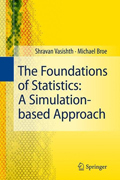
The foundations of statistics: A simulation-basedapproach
Vasishth, Shravan
Broe, Michael
Statistics and hypothesis testing are routinely used in areas (such as linguistics) that are traditionally not mathematically intensive. In such fields, when faced with experimental data, many students and researchers tend to rely oncommercial packages to carry out statistical data analysis, often without understanding the logic of the statistical tests they rely on. As a consequence, results are often misinterpreted, and users have difficulty in flexibly applying techniques relevant to their own research — they use whatever they happen to have learned. A simple solution is to teach the fundamental ideas of statistical hypothesis testing without using too much mathematics. This book providesa non-mathematical, simulation-based introduction to basic statistical concepts and encourages readers to try out the simulations themselves using the source code and data provided (the freely available programming language R is usedthroughout). Since the code presented in the text almost always requires the use of previously introduced programming constructs, diligent students also acquire basic programming abilities in R. The book is intended for advanced undergraduate and graduate students in any discipline, although the focus is on linguistics, psychology, and cognitive science. It is designed for self-instruction, but it can also be used as a textbook for a first course on statistics. Earlier versions of the book have been used in undergraduate and graduate courses in Europe and the US. á . ”Vasishth and Broe have written an attractive introduction to the foundations of statistics. It is concise, surprisingly comprehensive, self-contained and yet quite accessible. Highly recommended.” . Harald Baayen, Professor of Linguistics, University of Alberta, Canada . á . ”By using the text students not only learn to do the specific things outlined in thebook, they also gain a skill set that empowers them to explore new areas thatlie beyond the book’s coverage.” . Colin Phillips, Professor of Linguistics, University of Maryland, USA . Assumes only high school level mathematics (pre-calculus). Instead of formal proofs, simulations are used to explain the key concepts. Provides all source code to allow the reader to carry out the simulations themselves. INDICE: 1. Getting Started. 2. Randomness and Probability. 3. The SamplingDistribution of the Sample Mean. 4. Power. 5. Analysis of Variance (NOVA). 6.Bivariate Statistics and Linear Models. 7. An Introduction to Linear Mixed Models. A. Random Variables. B- Basic R Commands and Data Structures. Index. References.
- ISBN: 978-3-642-16312-8
- Editorial: Springer Berlin Heidelberg
- Encuadernacion: Cartoné
- Páginas: 178
- Fecha Publicación: 01/12/2010
- Nº Volúmenes: 1
- Idioma: Inglés
